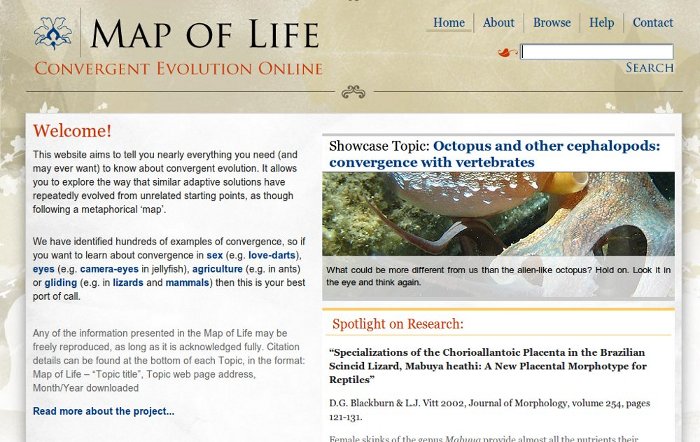Map of Life: A guide to convergent evolution
Posted by Nishal Patel, on 4 May 2011
The Map of Life is a recently published guide to convergent evolution produced by the University of Cambridge that has been touring science festivals and events across the world. It contains hundreds of article about structures and adaptations that have evolved independently in unrelated organisms such as camera eyes in jellyfish and snails to gliding in lizards and mammals.
This project is co-ordinated by the Professor of Evolutionary Palaeobiology, Simon Conway Morris in the Department of Earth Sciences. Professor Conway Morris and his team have spent several years on the project and the depth of the Map of Life really reflects this. The articles are all interlinked to each other, making it less of a list of convergent adaptations and more of a well linked database. I found myself wandering from camera eye evolution (they evolved 7 times!) to cognition in birds!
All the information presented here comes from peer reviewed journals and other scientific literature. Although this seems primarily aimed at students and academics it is written in a way that also makes it accessible to members of the public (with some basic understanding of science).
The Map of Life does a great job in showing off the beauty (and laziness!) of evolution and how it arrives at the same or similar adaptations independently. It also tells us that evolution can be predictable when faced with similar environmental or selective pressures and interestingly, could also give us some clues about how life could evolve on other planets or moons.
The main message that the Map of Life presents is that evolution is true. Whilst there are may proponents of evolution, what really separates this message from others is that it is funded by the John Templeton Foundation, an organisation that aims to align science and religion. Whilst this organisation has been at the centre of controversy recently, it is quite refreshing to see them displaying the marvels of evolution with a resource that is so accessible and absorbing.
Links:
Map of Life – http://www.mapoflife.org
Map of Life on Facebook – http://www.facebook.com/mapoflife
Press release from Cambridge University – http://www.admin.cam.ac.uk/news/dp/2011030302



 (5 votes)
(5 votes)
This is a very useful website for teaching.